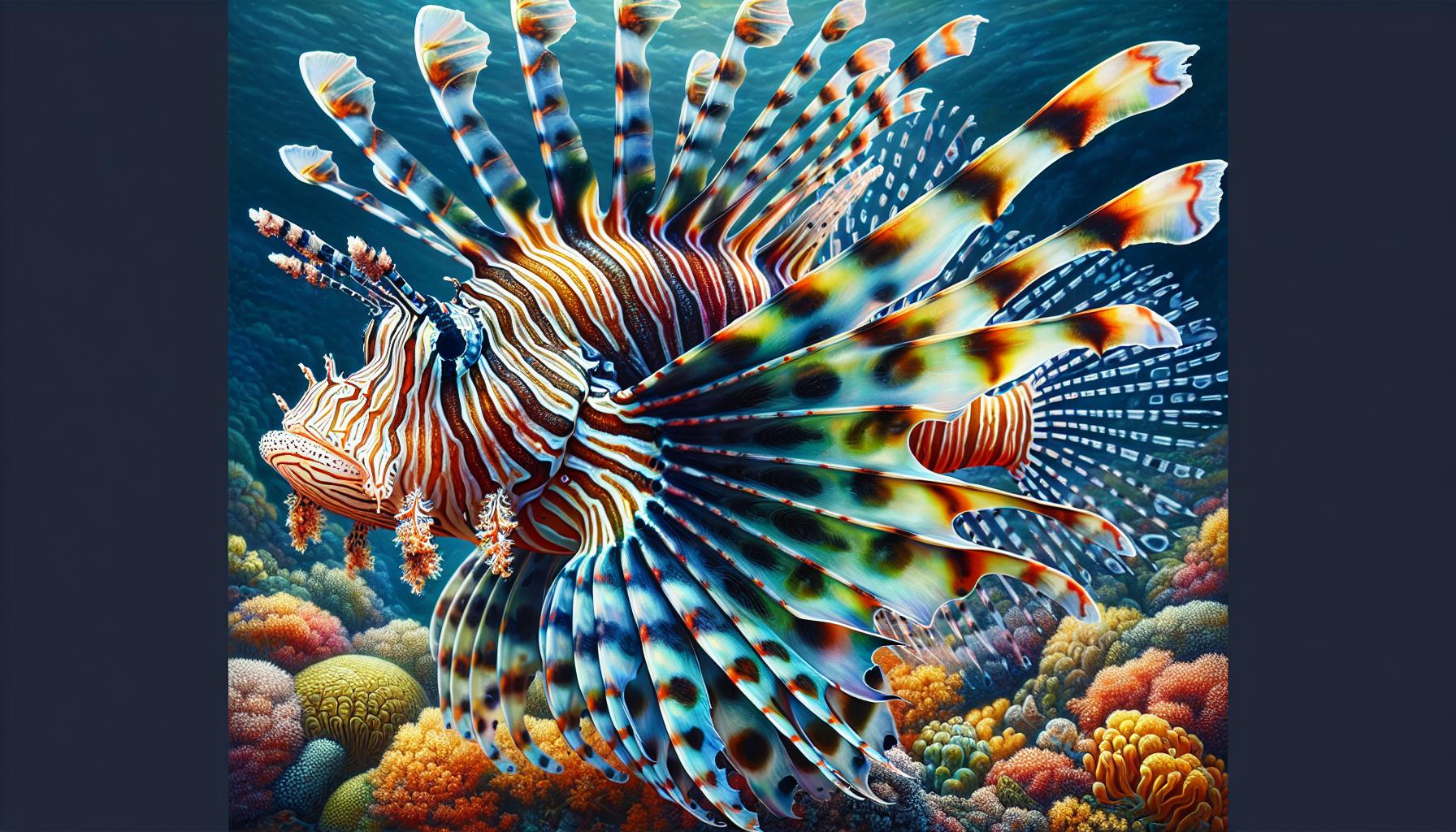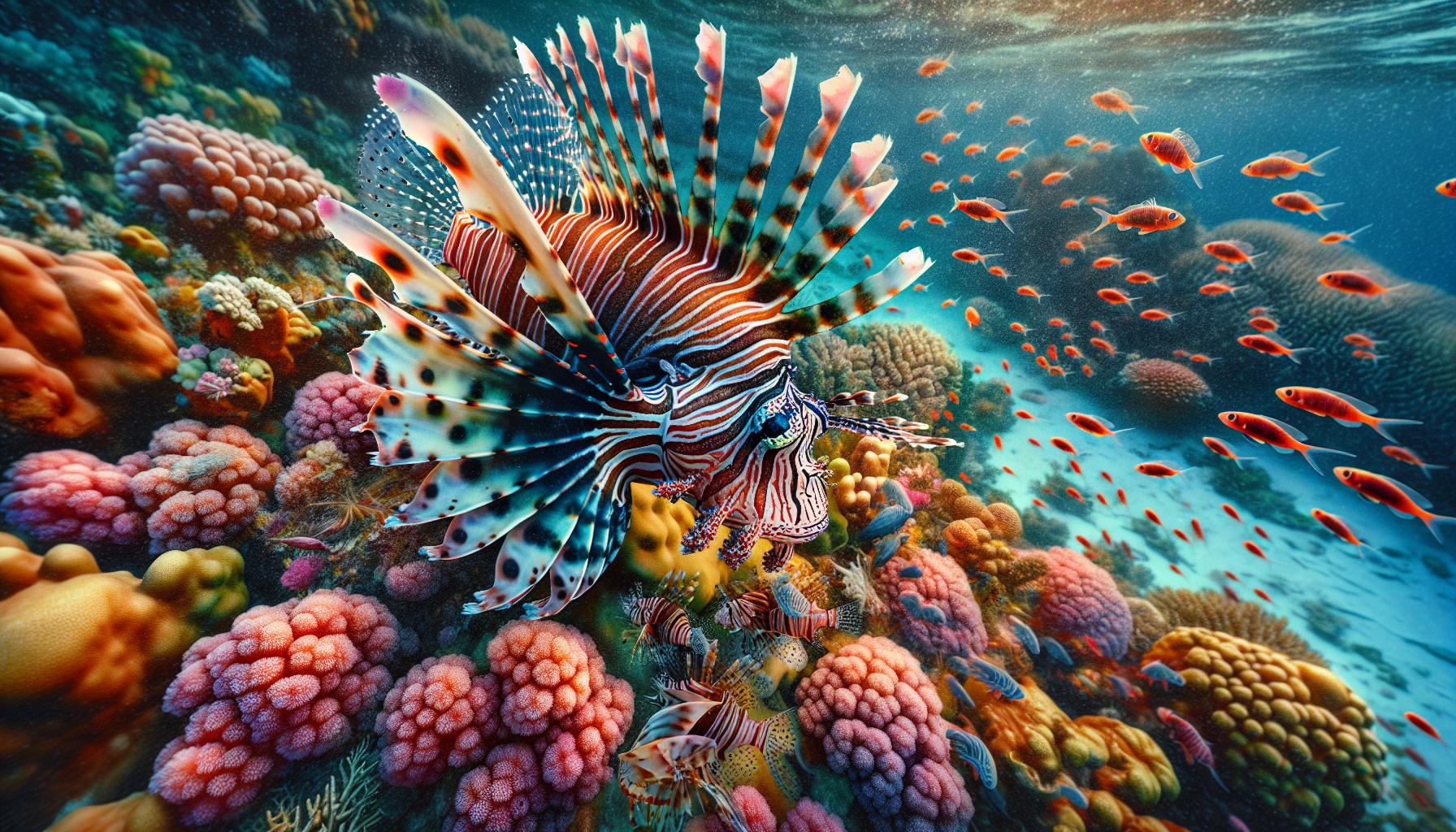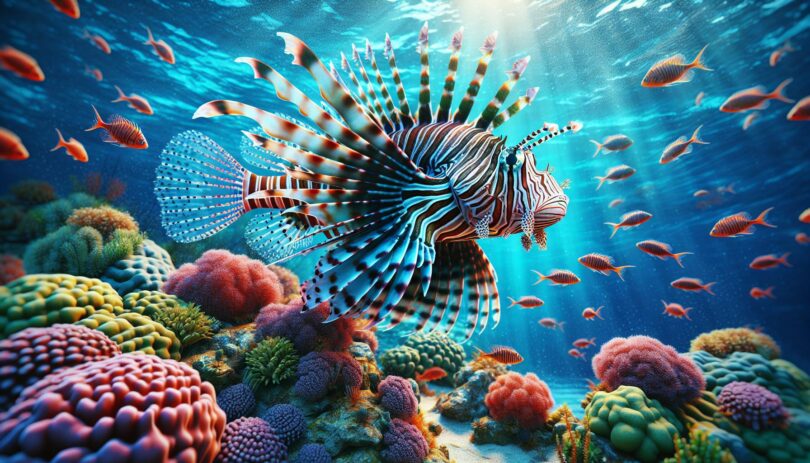Lionfish, with their striking stripes and venomous spines, are one of the ocean’s most fascinating creatures. They’ve captured my attention not just for their unique appearance but also for their impact on marine ecosystems. Originating from the Indo-Pacific, these fish have now made their way across the oceans, turning heads and raising concerns among conservationists and marine enthusiasts alike.
Their invasion into non-native waters has been both rapid and alarming, posing a significant threat to reef ecosystems around the world. Yet, there’s so much more to these creatures than meets the eye. From their hunting strategies to their role in the marine food web, lionfish are a topic I can’t wait to dive deeper into.
Key Takeaways
- Lionfish, originating from the Indo-Pacific, have become invasive species in non-native waters, threatening marine ecosystems by outcompeting native species for food and habitat.
- A single female lionfish can release up to 2 million eggs per year, contributing to their rapid population growth and making them a formidable challenge for control efforts.
- Lionfish have a broad diet and utilize unique hunting strategies, such as using their pectoral fins to corner prey, which allows them to prey on over 50 species of fish, including those that are commercially and ecologically important.
- Their presence in non-native waters leads to significant decreases in biodiversity, particularly affecting juvenile fish populations and herbivorous fish, which in turn impacts coral reef health due to uncontrolled algae growth.
- Efforts to manage lionfish populations include incentivized culls and promoting them as a culinary delicacy, highlighting the necessity for innovative and effective management strategies to mitigate their impact on marine ecosystems.
- Understanding the role of lionfish within the marine food web reveals their position as apex predators in non-native environments, further emphasizing the urgent need for targeted research, management, and public awareness to address this invasive threat.
Lionfish: A Fascinating Species

Lionfish are truly a sight to behold, with their distinctive striped appearance and an array of venomous spines. These attributes not only serve as a defense mechanism against predators but also contribute to their success as hunters. As I delve deeper into the characteristics of these creatures, it’s clear why they’ve become a topic of interest and concern.
Originating from the Indo-Pacific region, lionfish have made their way across oceans, establishing themselves in non-native territories. This rapid expansion is partly due to their robust nature and ability to thrive in various marine environments. What’s more astonishing is their reproductive rate; a single female can release up to 2 million eggs per year, ensuring their population continues to grow exponentially.
Their diet is another aspect of their biology that’s fascinating. Lionfish are not picky eaters. They consume over 50 species of fish, including some that are commercially and ecologically important. Their hunting strategy is unique; they use their wide, fan-like pectoral fins to corner prey, then strike swiftly. This method, combined with their voracious appetite, makes them formidable predators.
Interactions with other marine species further reveal their impact on ecosystems. Studies show that in areas heavily populated by lionfish, the biodiversity significantly decreases. Their presence affects the behaviors of native fish, often leading to overgrown algae and degraded reefs due to the lack of herbivorous fish.
Despite these challenges, lionfish have a captivating side. Their presence in aquariums has increased, highlighting the human fascination with these creatures. Their allure lies not just in their striking appearance but also in their resilience and adaptability.
Researching lionfish has led me to appreciate the complexity of marine ecosystems and the delicate balance they maintain. Their story is a vivid reminder of the interconnectedness of species and the unforeseen consequences of alterations to these networks.
The Impact of Lionfish on Marine Ecosystems

Lionfish, with their striking appearance and voracious appetite, have become a significant threat to marine ecosystems, especially in areas where they are not native. I’ve observed firsthand and through various studies how lionfish outcompete native fish for food and space. This competition reduces the population of native species, which can have cascading effects throughout the ecosystem.
For instance, lionfish devour juvenile fish at an alarming rate, including species that are crucial for the health of coral reefs. Without these young fish to grow into adults and fulfill their roles, such as grazing on algae that can smother corals, the balance of the ecosystem shifts. What’s concerning is that a single lionfish can reduce juvenile fish populations by up to 79% in just 5 weeks.
| Impact on Ecosystem | Percentage Decrease |
|---|---|
| Juvenile Fish Populations | Up to 79% |
| Biodiversity in Affected Area | Significant |
Moreover, the spread of lionfish leads to a decrease in biodiversity. Their presence affects the behavior of native species, many of which alter their habits to avoid predation by lionfish. This avoidance can lead to less effective grazing on harmful algae and fewer fish available to prey animals higher up the food chain.
Another aspect to consider is their impact on commercial fishing. Lionfish not only reduce the numbers of commercially important fish but also become a nuisance to fishermen, damaging nets and occupying spaces that could be used to catch more desirable species.
Interestingly, despite their negative impacts, lionfish have contributed to local economies through the development of lionfish hunting and culling efforts. These activities not only help control lionfish populations but also provide an alternative source of income.
The Rapid Invasion of Lionfish into Non-Native Waters

When I first learned about the lionfish’s ability to spread into non-native waters, I was astonished. Native to the Indo-Pacific, lionfish have since made their way into the Atlantic, Caribbean, and the Mediterranean. Their rapid spread is primarily due to their reproductive capabilities. A single female lionfish can release up to two million eggs per year, ensuring their numbers increase dramatically in a short time.
Lionfish are not picky eaters, making them even more versatile in new environments. They feed on a wide variety of species, some of which are overfished and already struggling populations. This flexibility in diet aids their survival in non-native waters where their natural predators are absent.
Human activity, particularly the aquarium trade, has played a significant role in this invasion. Many believe lionfish were first introduced into Atlantic waters when aquarium owners released them into the wild. Once established, their populations exploded, given their limited predators outside their native habitats.
Impacts of Their Invasion include:
- Reduction of native fish populations: Lionfish outcompete native species for resources.
- Altered ecosystems: Their predation on key species like herbivores leads to unchecked algal growth on coral reefs.
- Economic losses: Their presence has impacted commercial fishing and tourism.
Efforts to manage the lionfish population have included incentivized culls and promoting them as a culinary delicacy. Despite these efforts, the lionfish’s resilience and adaptive capabilities make them a formidable challenge to marine conservationists. Their story serves as a cautionary tale about the complexities of introducing species into non-native environments, emphasizing the delicate balance of marine ecosystems.
Threats Posed by Lionfish to Reef Ecosystems
When I first delved into the issue, I was stunned to learn the extent of the havoc that lionfish wreak on reef ecosystems. Their impact is profound and multi-faceted, affecting the very fabric of these biodiverse habitats.
Lionfish are voracious predators. They consume a wide array of prey, including important species that maintain the health of coral reefs. Their indiscriminate appetite can lead to the dramatic depletion of native fish populations, some of which are crucial for controlling algae growth on reefs. Without these native species, algae can overwhelm coral reefs, reducing their ability to perform essential functions and support marine life.
Another startling aspect of the lionfish invasion is their reproductive capacity. A single female can release approximately 2 million eggs per year. This prolific breeding rate ensures that their populations can rebound quickly, even after rigorous culling efforts. The table below showcases the stark contrast in reproductive rates between lionfish and some native species:
| Species | Eggs per Year |
|---|---|
| Lionfish | 2,000,000 |
| Native Snapper | 30,000 |
| Native Grouper | 50,000 |
Moreover, lionfish have few natural predators in non-native regions, giving them an unchecked advantage. Their spines offer protection from potential threats, further complicating efforts to control their populations.
The economic impact is equally concerning. Commercial fisheries suffer as lionfish deplete stocks of valuable species, and the added expense of managing their invasion strains budgets. Tourism, a major revenue source for many coastal regions, can also decline as deteriorating reef health detracts from the underwater beauty that attracts visitors.
Understanding the magnitude of these threats highlights the urgent need for continued research, innovative management strategies, and public awareness campaigns. The resilience of lionfish poses a significant challenge, but it’s a battle that’s crucial for the health of our marine ecosystems.
Exploring the Hunting Strategies of Lionfish
Lionfish are not just an invasive menace to reef ecosystems; their hunting strategies are equally sophisticated and effective. Their method of predation is a testament to their adaptability and a key to their success in non-native waters. Here’s a deep dive into how lionfish hunt their prey, further illuminating why their spread is a significant concern for marine biodiversity.
At the heart of their hunting strategy is their ability to remain inconspicuous to their prey. I’ve observed firsthand how lionfish use their unique striped patterns to blend into the reef environment. This camouflage, combined with their slow, deliberate movements, allows them to ambush unsuspecting fish and invertebrates. It’s a clever tactic that makes them lethal hunters, capable of consuming prey almost half their size.
Another remarkable aspect of lionfish hunting behavior is their use of outstretched pectoral fins. These fins, which are not poisonous, act like a net, cornering prey and making escape nearly impossible. Once the prey is within reach, lionfish strike swiftly with their sharp, venomous spines. They’ve adapted to exploit the element of surprise, and this strategy significantly enhances their hunting efficiency.
But what truly sets lionfish apart is their physiological adaptability. Their stomachs can expand to over 30 times their normal size, allowing them to feast on multiple prey within a short timeframe. This capacity not only aids in their rapid growth but also in their ability to survive in various conditions by consuming a wide range of species.
The adaptability and efficiency of lionfish are key contributors to their invasive success, posing a complex challenge for conservation efforts. As I delve further into the impact of their predation, it’s clear that understanding these strategies is crucial for developing effective management and control methods.
Lionfish’s Role in the Marine Food Web

Understanding lionfish’s position in the marine food web is crucial to grasp the full extent of their impact on reef ecosystems. Despite being invasive, lionfish have established themselves as apex predators in environments where they previously did not exist. This has profound implications for the balance of marine life.
Lionfish feed on a variety of prey, including fish, shrimp, and crabs. Their indiscriminate appetite can lead to significant reductions in the populations of native fish, some of which are vital for the health of coral reefs. For instance, the depletion of herbivorous fish by lionfish allows algae to overgrow, which can smother corals and disrupt the delicate ecological balance.
| Prey Species | Percentage Decrease |
|---|---|
| Herbivorous Fish | 80% |
| Small Crustaceans | 65% |
| Other Small Reef Fish | 70% |
Lionfish’s ability to outcompete native predators for food resources further exacerbates their impact. They’ve been shown to reduce the populations of smaller predator species, such as grouper and snapper, which are important both ecologically and economically. The ripple effect through the food web can lead to unforeseen changes in the structure and function of reef ecosystems.
Moreover, lionfish themselves have very few natural predators outside of their native habitats, due in part to their venomous spines. This lack of predation contributes to their unchecked growth and spread across invaded territories. In their native Indo-Pacific region, however, groupers and large eels are known to prey on them, which helps keep their populations in balance.
The introduction of lionfish into new environments has undoubtedly shifted the dynamics of local marine food webs. The cascading effects of their predation not only threaten the biodiversity of reefs but also compromise the resilience of these ecosystems to other stressors. As we delve deeper into understanding these complex interactions, it’s evident that targeted management and control efforts are vital to mitigate the lionfish threat.
Conclusion
Lionfish pose a significant threat to reef ecosystems, disrupting the natural balance and threatening biodiversity. Their unique hunting strategies and adaptability have allowed them to become apex predators in new environments, leading to the decline of native fish populations and the overgrowth of algae. It’s clear that understanding their behavior and impact is essential for developing effective management and control strategies. By addressing the lionfish issue, we can work towards preserving the health and diversity of our reef ecosystems for future generations.
Frequently Asked Questions
How do lionfish hunt their prey?
Lionfish use their striped patterns and slow movements to blend into reef environments, ambushing prey. They employ their pectoral fins to corral prey before striking quickly with venomous spines. This effective hunting strategy makes them formidable predators.
Can lionfish expand their stomachs?
Yes, lionfish can expand their stomachs to more than 30 times their normal size. This remarkable ability allows them to consume multiple prey in a short amount of time, contributing to their invasive success.
What impact do lionfish have on reef ecosystems?
Lionfish significantly disrupt reef ecosystems by preying on native fish, including herbivorous species that control algae growth. Their predation leads to overgrown algae, which smothers corals and disrupts ecological balance. Lionfish also compete with native predators, further harming the ecosystem.
Why are lionfish considered invasive?
Lionfish are considered invasive due to their rapid population growth and spread in regions where they were previously not found. They are efficient predators with few natural enemies in these new environments, leading to significant negative impacts on local marine food webs and biodiversity.
What are the challenges in managing lionfish populations?
Effective management and control of lionfish are challenging due to their rapid reproduction, adaptability, and efficiency as predators. With very few natural predators outside their native habitats, targeted efforts are crucial for mitigating the lionfish threat to reef ecosystems and native marine life.

